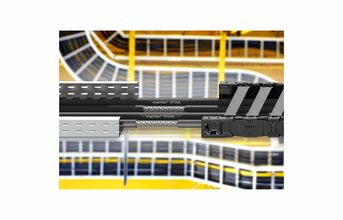
With the new chainflex cable CF33.UL, igus has developed the world's first motor cable for energy chains and cable trays with UL approval and a four-year functional guarantee in the energy chain. This allows the cable to be laid from the energy chain to the cable tray without a plug connection in between. The CF33.UL also adds a shielded PVC motor cable to the chainflex range.
What makes them special is their UL listing ("Flexible Motor Supply Cable according to UL 2277"). Usually, UL-listed cables are only intended for fixed installation or occasional movement. UL approval for continuously moving energy chain cables has not existed up to now.
"With the new motor cable, we are offering our customers a cable type that is suitable for both chains and cable trays. A plug connection is no longer necessary," explains Rainer Rössel, Vice President and Head, Chainflex Cables Business Unit, igus. Users also avoid duplicated stock of cables for the chain and fixed installation. igus puts its cables through their paces in its own 3,800-square-metre laboratory. Thanks to this series of tests and 30 years of experience in the field of moving cables, igus has recently extended the guarantee on the new motor cable to four years or ten million double strokes.
igus also uses the data from the laboratory for its online tools, such as the chainflex service life calculator.
Here, customers can determine the cables' durability in their applications online. That way, chainflex cables allow customers to further improve the sustainability of their applications. The reason is that a cable that is replaced too soon or breaks entails a correspondingly high CO2 impact due to producing and transporting a substitute.


























